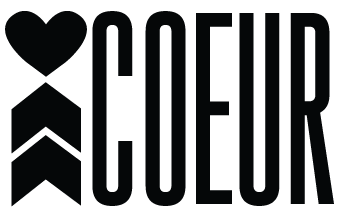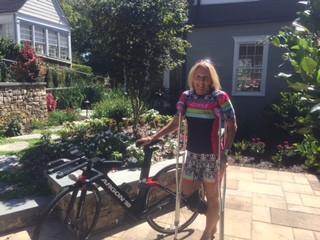Coeur Sports Ambassador Laura Sophiea has fought through tough races, but her battle with a severe knee injury was one of her hardest fights. We asked her to write about it and in this incredibly open and compelling blog, she shares the story of her injury and lessons learned. Here's her post:
“Nobody succeeds beyond his or her wildest expectations unless he or she begins with some wild expectations.” – Ralph Charell
I was not one to believe in quotes or sayings. But I’ve looked at that quote every day for the past 17 (and counting) months. This past year and a half has been the most challenging mental roller coaster of my entire life and I want to share it with you. Here’s how I got to where I am today…
Heading into Kona 2015, I felt at the top of my game. I was in my first year in the 60-64 age group and was feeling very excited and confident leading up to the race. Then about eight weeks before the race, everything changed. I first had a twinge in my quad in July 2015 and was diagnosed with quad tendonitis. My first MRI was in September 2015. That same evening I had a total body collapse and found myself on crutches less than a month before Kona. I started having severe pain in my knee. I saw doctors in Atlanta and doctors in Kona, all of which told me that running the marathon wasn’t in my best interest. But at this point, I was already in Kona and wanted to win my age group to get the KQ for 2016. It was also my 25th Kona and I wasn’t ready to close the book on #25 before it even started. My youngest daughter and her boyfriend had flown out for the race and did everything they could to keep me focused and help in any way possible. I did not run at all in Kona until two days before the race, I did the Underpants Run with the Coeur team and knew this was far worse than I had thought. For the next two days, I was walking around on a crutch and had my knee in a massive brace.
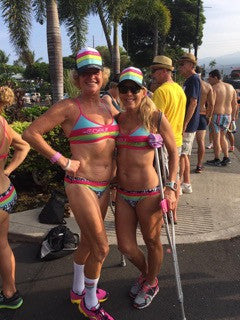
I had shut down and given up hope that I was going to be able to run. With the help of my daughter, and many others, I decided to at least start the race and if I couldn’t run, I couldn’t run (the thought of that demoralized me, because I am no quitter and I come to Kona with the hope of the podium every year).
Then came race day. I felt great on the swim and bike with no pain at all. I got off the bike with about a 30-minute lead in my AG and just started to run. And somehow, it worked (thanks adrenaline!). I saw my daughter on the first stretch on Ali’i outside of our condo and her face lit up as soon as she saw I was running. She ran beside me and let me know that I looked great and had a 30-minute lead. That was all I needed to keep going. Needless to say, I did not run anywhere close to the entire 26.2… there was A LOT of walking. I made it about nine miles before the pain set in. After the longest marathon of my career (and first 12 hour Kona), I finished with first place in the 60-64 AG by about four minutes. I sobbed – at the time in joy because I had done it – but shortly after the pain set in. Bad. After the race, I couldn’t walk and was on two crutches. But I had my spot for 2016 and thought I had plenty of time to recover and fix my knee. Little did I know what the next year would bring.
Less than a month after Kona, I had my first surgery, which I should tell you now, was the wrong one. They found a soft lesion or hole in my medial femur bone and I was told it was an easy fix. I was in severe pain after the surgery and had no relief. I thought that was just post-surgery pain but turns out, the surgery was not what I needed and my knee would not be getting better any time soon. After multiple opinions, I learned that it was the wrong surgery and was told the first was a complete failure – the doctor had missed the lesion entirely (how that is even possible, I have no idea). At this point, I had gone October to July with severe knee pain every day and was completely unable to run. To this day, I harbor resentment toward that first doctor and his ability to lie to me and tell me my surgery was a success when I had now been living in complete pain for over six months.
In April, I met Dr. Kercher of Peachtree Orthopedics (truly my hero) and he explained that I needed an allograft (cadaver bone to fil in the hole in my knee). He would also have to break my tibia and move it 10 degrees to the right. Or I could get a partial knee replacement. I had many differing opinions from friends and family. My kids told me to do what I needed. In the meantime, I was doing Aquabike races, which when you’re a triathlete, is a little like kissing your brother. I loved being outside and racing again and was thankful to be doing some activity, but it just wasn’t the same and pushed me deeper into my depression.
In July, I had the allograft surgery. But this surgery meant being sidelined for another 8-12 months (absolutely NO running), which meant everything I put my body through was for naught – I wouldn’t be doing Kona 2016. This was one of the hardest things I’ve ever dealt with mentally in my life. Take someone who has been doing and training for triathlons for the last 30 years and tell them no running. But I knew mentally I needed to be all in for this surgery and believe my surgeon when he said if I did everything I was supposed to, I would run again. I’d be lying to you if I said that I wasn’t 100% scared and worried that I would never run again. But I had to BELIEVE. Believe in Dr. Kercher, believe in my ability to stay strong and focused and love my life. I knew I was tough and strong enough to get through this.
August and September were trying (to say the least) Wow is truly all I can say. I was in so much less pain and had relief… but I couldn’t do anything. After all, my tibia was broken. I started PT and started a plan to get back on track.
None of this was easy. I was able to be on my bike trainer after two weeks with zero resistance. I was so happy but it was so challenged. I focused on what I could do and continued to believe in my ability to become stronger each day. Each day was a journey. I couldn’t drive, so I Ubered to and from PT. I was on crutches for 10 weeks. I had to stay steadfast with my determination and grit. Above all else, I had to believe in a dream that I would one day be running again. My doctor believed I could do it, so I did as well.
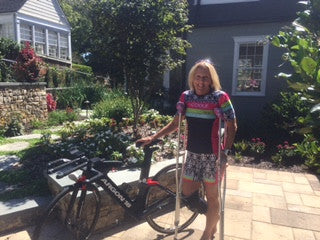
Kona was bittersweet. I had four athletes racing and headed to Kona with them to be part of the festivities and be part of the Coeur cheering squad. Cheering on my athletes and teammates was so fun and special for me. But internally, it was also so tough. Not racing was so incredibly hard for me. It took a lot but I knew I had to put on a happy face. However, after swimming in the ocean and riding on the Queen K (my first ride outside) was very cathartic for me. I cried tears of joy that day and knew that the hardest part of my journey was behind me.
From November to January, I continued with PT twice a week and became a gym rat. Working my upper body trying to build strength back. I am so thankful for my physical therapist and everything she taught me. Then came my six-month checkup on January 24. Let me tell you, I can’t even describe the anxiety that led up to that day. My doctor was completely stunned – my tibia bone was 100% healed. The allograft takes more time to fully assimilate into my body but so far so good. I was given the green light to water run, elliptical and use the Alter G treadmill at PT. Running on the ground will be a work in progress this year but slow and steady, I will be pain free.
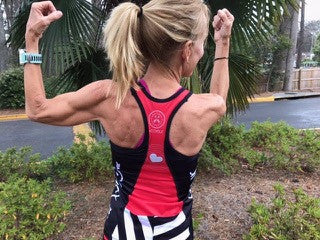
As for the future, my goal is to race IM Chattanooga 70.3 and be able to run/walk the 13.1 miles. Just like during an Ironman, I need to dig deep down and arrive at that finish line. My mantra now is three simple words – Courage. Commitment. Perseverance. I’ve learned a lot about myself and my mental toughness this past year and a half but here’s my top takeaways:
- Always have a second opinion even if your doctor is a legend.
- Be fully present each day. Even when you do not want to do the work, do it.
- The most important qualities in a mentally tough triathlete are: resilience, focus, strength, preparation, vision, openness and TRUST.
- Never give up EVER. Find a doctor and a team who believe in you and your plan. And then believe in his.
- Believe in yourself EVERY single day. Through the ups and the downs, the tears and the pain, this is the most important lesson I have learned. It’s not easy, it takes daily work and daily love and support of friends and family.
I know I will be a different athlete now but the goal is to one day be back in Kona doing the Ironman World Championship and I believe it will happen. Thanks for taking this journey with me!
